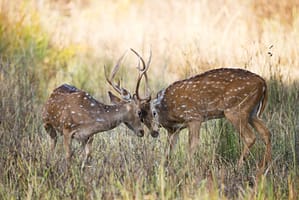The Kanha forest had been a little explored wild forest under the rule of the Gond dynasty for many centuries before it was demarcated as a National Park in the 20th century. They practised agriculture in harmony with the animal kingdom. In 1862, under the British rule, the first laws were laid out to protect certain plant species in the Kanha region and cutting of certain trees like Sal, Teak, Sesham were prohibited without prior permission. In 1879, following the publishing of literature on the highlands of the Kanha forest, the area was declared a forest reserve. Soon after this, the Kanha Forest and its spectacular landscapes became the backdrop of Mowgli’s famous adventures in Rudyard Kipling’s “The Jungle Book”. Over the next few decades, many biologists and naturalists studied the flora and fauna of the Kanha reserve. In 1933 the forest was declared a sanctuary. Following independence, the Kanha forest was declared a national park in 1955. In the decades that followed, the core of the forest reserve was carefully demarcated and villages were relocated to the buffer zone. In the 1980s and 1990s special efforts were made to preserve the Barasingha species and upgrade the National Park’s infrastructure to attract more visitors and encourage safe and friendly tourism. This resulted in the Park being awarded the most tourism-friendly accolade in 2000 by the central government.
Kanha’s culture is dominated by the commitment of its inhabitants to maintain the ecosystem. They celebrate nature and the beauty of the animal kingdom, from afar, and all their efforts are geared towards preserving the wildlife abound in this reserve. Most people travel to Kanha to spot the elusive Indian tiger. Tiger spotting safaris are organised in the morning when a tiger has been spotted by the rangers. The safari tours that are conducted twice a day in morning and evening shifts reveal the hidden secrets of the forest where you can spot the various animal and bird species that call Kanha home. These include but certainly are not limited to the tiger, Barasingha deer, Indian wild boar, flying fox, hyena, Sambar, flying squirrel, sloth bear and many more. With a range of modest to luxury accommodations to choose from, a trip to Kanha is the best way to converse with the wild nature in the heart of India.

